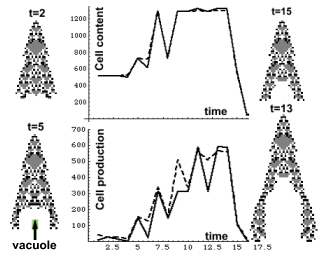 |
Mutual Impact
Hitherto we studied various aspects of CA mutual impact:
1. Both CAs control each other.
2 .Impact and cell production.
3. Stable relationship,
In all three experiments, impact ={i, j} was driven
by the program. In the present experiment CAs
adjust their mutual impacts so as to produce more cells. In the
graphs, CA-1 is depicted by solid
lines and CA-2 by dashes.
 |
Program outline
Step = 0. Set the initial conditions:
1. Two zygotes are planted (their color =1)
2. The rule = #600
3. Initial impact ={i0,
j0} which sets the initial death threshold.
4. Create a cell production register cell(previous) = 0.
Step = 1.
Let the CAs
grow until reaching their maximal size (steady state). Their cell production
is stored in a register.= Cell(now). The difference between cell(now) and
cell(previous) sets the new impact
= {i1, j1}. Store cell(now) in cell(previous). Plant two zygotes. Go to
step =1
Stop when each of the two zygotes fails to generate
a CA
All states in a CA may be updated in parallel. You
plant two zygotes and let the CAs evolve into their maximal size. From then
and on you may update their states (rows) in parallel. During each step the entire CA is updated. It stores its cell
production / step in cell(now) computes its new impact, and adjusts all
its states (rows) in parallel.
Holocrine secretion
As cell production rises the CA is filled with white cells. This space is called vacuole. This phenomenon is observed in sebaceous glands, and called holocrine secretion. Vacuole size is proportional to cell production.Throughout the experiment the two CAs stimulate each other more and more until they die from exhaustion.